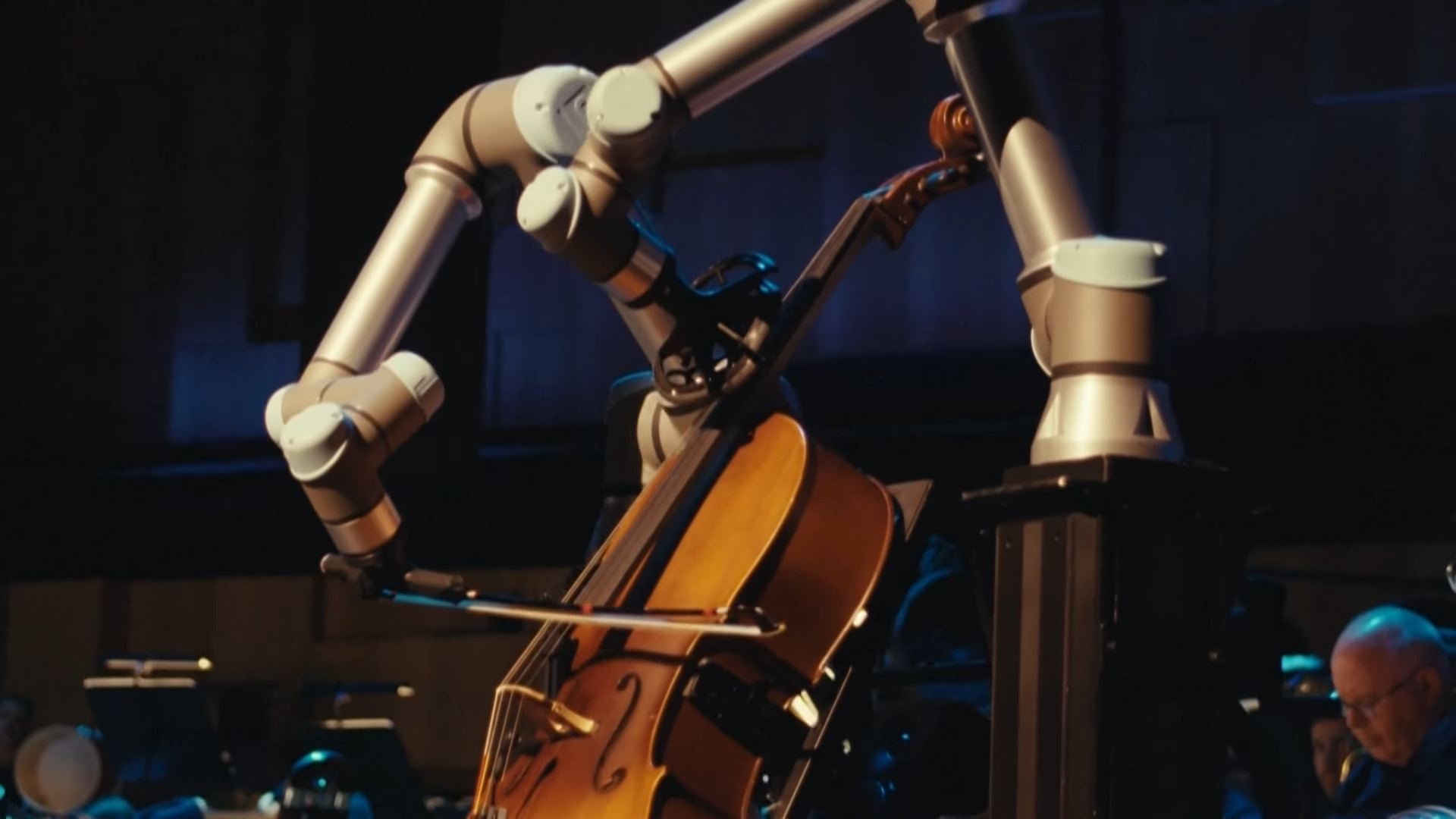Robots can play the cello with an orchestra now, and that sound you can hear is the point whistling over the top of its creator's heads
Technically perfect, completely soulless. That's what I love about my favourite musicians.

I would describe myself as many things. Writer, long-haired moron, the most spectacular lover this side of the Milky Way. But one term I would also use to describe myself is: A musician. Not an exceptionally good one, I have to say, but I've been known to take a stringed instrument and throttle it to within an inch of its life for paying punters, and for my own enjoyment, too.
Which is why, when I found myself watching footage of a pair of robot arms playing the cello with the Malmö Symphony Orchestra, I felt a range of competing emotions. On the one hand, it's an impressive technical achievement, and one to be admired. On the other, I looked into the faces of the orchestra members sitting behind it, watching their beloved art form reduced down to a sequence of quite literally robotic motions, and felt a pang of existential dread and sympathy rolled into one.
Technically, it's a competent performance. One arm making smooth bow motions, the other wielding a circular appendage that manipulates the fingerboard to approximate the fingers of a skilled player. The pitch is on point, the timing immaculate.
The performance? Soulless, as you might expect. Because even at a professional orchestral level, what audiences pay to hear is a real-life human being, feeling the notes as they play. The point of an instrument is to be used, as a tool, to convey the feelings, thoughts, and inner workings of one human being to the minds, thoughts, and dare I even say it, souls, of the other humans listening to it.
That's not what's here. Partly, there are some technical limitations to blame. That circular fretting appendage doesn't appear to be capable of vibrato, so there's no manipulation of the notes to add character and depth, a subtle shaking of the wrist or adjustment of finger tension to add character to the part.
All good string players know that it's not so much what you play as how you play it, and this collection of robotic limbs is doing its darndest to play everything spot down the middle—which any good music teacher will tell you is not the point.
But more than that, it's the existential factor that really makes this such a solemn, sad, almost grotesque watch. Here the audience sits, in front of a collection of humans that have dedicated their lives to understanding, living, breathing their craft, pushing themselves every day to create real emotional responses in all those who listen.
Keep up to date with the most important stories and the best deals, as picked by the PC Gamer team.
To the side of them, sits the machine. It is incapable of doing these things. All it can do is play a stilted, haunting rendition of something so desperate to be alive. It does it with brutal efficiency. It is a sideshow, a carnival ride, an attraction in front of a trade show stall.

Best CPU for gaming: The top chips from Intel and AMD.
Best gaming motherboard: The right boards.
Best graphics card: Your perfect pixel-pusher awaits.
Best SSD for gaming: Get into the game ahead of the rest.
It knows nothing of what those notes mean. It sees no more soul in them than it does joy in a line of code. It is bereft of context, of heart, of emotion. It is dead.
It may be the future of music, in some form or fashion, and if so we will be all the worse for it. We go to concerts to see, feel, and experience something real, and that includes character, mistakes, and the defining things that make us human.
This automaton is none of those things. All it makes me feel is sad, and that has nothing to do with the tune it's playing. It's a figurehead, for AI, for robotics, for everything that's wrong with the tech industry as it stands right now.
We want machines to take away tasks from us that are monotonous, repetitive, tiresome and boring. Instead, we increasingly see them used to reduce the creative, wonderful, life-giving aspects of our existence to nothing more than a repeatable, quantifiable, and marketable zero sum.
Listen to the robot, my friends, and weep. It plays a song of desolation for us all.

Andy built his first gaming PC at the tender age of 12, when IDE cables were a thing and high resolution wasn't—and he hasn't stopped since. Now working as a hardware writer for PC Gamer, Andy spends his time jumping around the world attending product launches and trade shows, all the while reviewing every bit of PC gaming hardware he can get his hands on. You name it, if it's interesting hardware he'll write words about it, with opinions and everything.


